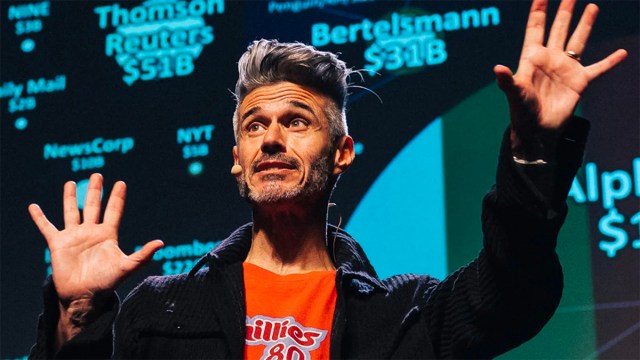
TL;DR
- Creative producer and VFX supervisor Eric Alba, dotdotdash executive director of technology Adam Paikowsky, and ASHER XR founder and CEO Christina Lee Storm discuss current technology trends pushing the boundaries of storytelling.
- This trio of industry pros will lead a networking session at NAB Show New York titled “Leveraging New Tech For Storytelling,” exploring practical applications of emerging technologies from personalization to multiplatform interactivity.
- The experts highlight the transformative power of technologies like Unreal Engine and generative AI, emphasizing their role in creative expression and collaboration.
- Paikowsky singles out spatial computing as the “next frontier of interactive technology,” offering a glimpse into its potential to revolutionize storytelling.
Amid a groundbreaking era of technological innovation, the Media & Entertainment industry is not just adapting but evolving. From digital media to multiplatform interactivity, technology is acting as a catalyst, opening up new avenues for creative expression.
This October, M&E professionals will gather at NAB Show New York to discuss, challenge, and inspire one another on the emerging technologies shaping our creative future. As a prelude of the event, running October 24-26, we spoke with a trio of industry pros about current trends pushing the boundaries of storytelling.
The conversation, which included creative producer and visual effects supervisor Eric Alba, dotdotdash executive director of technology Adam Paikowsky, and ASHER XR founder and CEO Christina Lee Storm, focused on real-time workflows, the power of generative AI and procedurally generated worlds, and non-linear storytelling using AI and immersive technology.

The Catalysts of Change
“I think it’s a bit of a kitbash of a lot of different technologies in service of a sector or several sectors that are merging together,” Alba says of the forces driving the current evolution in storytelling. He emphasizes the role of Unreal Engine, stating that “the ability to create worlds procedurally inside the engine is becoming very interesting.”
Asset creation itself hasn’t really changed, “it’s only gotten faster and with better fidelities,” he notes, but generating worlds procedurally helps extend realities or expand worlds, “whether they be virtual or IRL.”
Storm, who prior to founding ASHER XR served as director of virtual production at Netflix, is equally excited by real-time workflows, but also points to the collaborative environment these tools provide.
“It’s very akin to when you’re in a room and you’re talking through ideas and such,” she says. “The toolsets are now improving as well as evolving in a way where we can actually see things in real time and we can actually participate in a way where we don’t have to wait.”
Instead of waiting overnight for renders, “you can actually get into a place where people can come together in a sandbox-type environment and really start to formulate their creative process.”
Taking real-time tools from production environments all the way through to delivery and beyond, is also intriguing, Alba adds. “What’s funny is that, theoretically, a lot of these technologies can be both used for development, ideation, prototype, rapid prototyping, all the way, and then completely just switch to production and execution, and even driving live shows,” he says, pointing to the live entertainment sector. “That’s what’s interesting.”
Spatial Computing as the Next Frontier
When asked about the technologies that truly ignite his imagination, Paikowsky didn’t hesitate: “Spatial computing is where it’s at.” Coined by former MIT Media Lab researcher Simon Greenwold in 2003, spatial computing brings together the virtual and physical worlds in a seamless way. It can be employed for things as mundane as lights that switch on when a person enters a room, all the way to digital twins of physical environments duplicated down to the smallest detail.
Describing it as the “next frontier of interactive technology,” Paikowsky believes this emerging field has the transformative power to “bridge the gap between what we’re seeing on our phones and on our screens, and put it into the real world in an interesting way.”
However, Paikowsky also pointed out that the current applications of spatial computing are “quite interesting, but also kind of limited.” He suggests that the industry is still in its infancy, grappling with the challenges and opportunities this new medium presents. “I think it’s just about experimenting and starting to play in the spaces and understand, you know, what works and what doesn’t,” he said, emphasizing the need for trial and error.
One of the most intriguing aspects of spatial computing, according to Paikowsky, is its potential to change the context in which stories are told. “Speaking spatially is a different part of your brain and being spatially in a way that supports the story is really interesting,” he noted. This opens up new avenues for storytellers to experiment with context, much like how theater uses the concept of a “fourth wall” to engage audiences.
Paikowsky also issued a word of caution against merely replicating existing storytelling methods in spatial computing. “The pitfall or the red herring would be trying to do the same thing you’re doing now with a new medium,” he warned. Instead, he believes that the “big wins are actually going to be people who sort of do something different and try and push in a new way.”
Creative Use Cases in Modern Storytelling
As the industry navigates the ever-changing landscape of technology, the question of its practical application in storytelling remains at the forefront.
Paikowsky points to personalization as the future of storytelling. “I think we’re going to start to see a massive shift in traditional content production using real-time workflows in order to, one, be more collaborative, but to also create more scalable personalization,” he says, using targeted commercials as an example.
“Right now, you have, like, your 15 -second text that you use for that commercial, and it’s very broad. You’re going to make, like, three of them,” he explains. “But in the future, with a real-time production pipeline and real-time graphics, you could actually make hundreds of them using the same structure, but swapping up products that are more relevant to one person or another. It’s very similar to the way performance marketing works, which is all the targeted marketing you’re seeing on Facebook, or banner ads and things like that. But with new workloads, you can really drive personalization.”
Storm is particularly excited about exploring creative use cases at the upcoming NAB Show New York networking session, “Leveraging New Tech For Storytelling,” which employs a round-robin format allowing attendees to gain first-hand insights in small interactive groups.
“We’re going to talk through some creative use cases, things that have worked, things that folks might want to try,” she says. For Storm, the magic happens when “different artists, different backgrounds, different mindsets come in to figure things out.”
Alba echoes this sentiment, emphasizing the need to “understand the process of how these tools work together” and to consider the end deliverable. Whether it’s linear media content or an interactive, location-based experience, the technology should serve the storytelling. “You have to look at the use case of what you’re delivering at the end,” he advises.
While new technologies offer a plethora of tools and platforms, it’s the creative use cases that truly unlock their potential. As Storm puts it, this is the space “where ideas come together,” and it’s this collaborative, purpose-driven approach that our industry experts agree will shape the future of storytelling.




